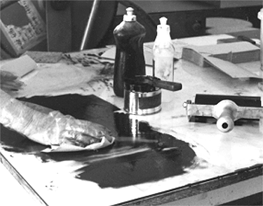Polyester plates
Digitally created polyester plate lithographs
Printing techniques for polyester plates
Drawing materials for polyester plates
Surface printing drawing materials and relief printing of polyester plates
-----
Polyester plate lithography
Keith Thompson, Tomographical survey #3, Polyester Lithograph and screenprint
Creating Images on the Plates with a Laser-printer or Photocopier. In the printing industry, images are transferred to polyester plates by running the plate through a laser-printer or photocopier. This creates a durable toner-image on the plate which forms the ‘ink- base’. This is the fastest and easiest application of the plate and as it requires no further processing or chemicals treatment before printing, it is incredibly quick to prepare an image to print. Images will print darker than that on the plate so it is important to lighten the over all image to compensate for this factor. When using a digital output simply adjust the values of the image prior to putting the plate through the printer. With a copier adjust the light to dark settings.
Drawing
Materials for surface printing
Straw hat for solid brushwork, straw hat varnish and meths washes.
Straw hat, being a shellac based varnish dries rapidly producing a tough durable
mark. If layers are overlapped after drying, a visible layering will be visible
as the hard shellac rolls up as a relief-mark.
Soft washes can be produced by wetting the plate with meths and adding straw-hat onto this. Brushing water or gum arabic into this wet solution will produce white marks or outlines, depending on how much the varnish has dried. white spirit will cause the varnish to repel, gouache will create crazing and globules.
Health and
Safety
Straw hat is an unpleasant material which gives off strong fumes, it should be
used in a well ventilated area. At Edinburgh Printmakers, when it is
occasionally used as a drawing material for surface lithography, it is used in
an area with a local vent hood.
Acrylic paint - (not flow formula acrylics),
Acrylic impasto mediums
Acrylic paint can be used to create solid brushmarks, and if painted thickly
some impasto effects can be achieved as the paint will roll up as a relief
print. This effect can be heightened by adding acrylic mediums to the paint such
as Liquitex acr ylic texture gel- modelling paste. With a hog hair brush this
can produce unusually three- dimensional impasto brush effects.
Gouache and
gum lifts
Gouache lifts- Paint the gouache onto the plate, diluting with more water to
leave only edges or use neat to block out solid marks.
Once dry:
1. Apply straw hat/ meths mixture. Any streakiness of the coating will show so
this can be used to creative effect. ie add dribbles and spatters etc, dry and
add a second layer of dry brushing, paint over certain areas more to block out
the background as a solid.
2. Air dry the straw hat varnish for 3 minutes then lift the gouache by placing
the plate in atray of cold water, sponging.
3. Apply mid strength plate etch, sponge over for two minutes, buff dry with
scrim.
4. Allow the plate to dry t for 30 minutes.
Prime with inkthinned with solvent, then sponge the plate and ink with a hard
roller and stiff/ lean ink
Spray paint
and airbrushed acrylic
Spray paint can be used to create tones and gradations, areas can be masked with
gum arabic or gouache prior to spraying or masked between layers of spray to
create tonal mar ks and shapes. Borders can be masked with gum or masking tape.
When applying sprays take-care- SPRAY VERY SPARINGLY, check tone by peeling tape
of margin to compare. Expect the spray to print darker than it appears.
Sprays that have been used-
Acrylic varnish (Klear) coloured with flow formula acrylic. Water can be used to
paint into, lift off and create spatters during the drying of the spray.
Halfords Satin black. - very fine spray, visible, easy to judge tone.
Plasti kote- white Kitchen enamel spray. Lifts off from plate gradually unless
well dried (and heated) prior to printing.- White colour is harder to judge when
spraying, but easier to see the ink film when inking.
Photocopy
transfers
Good quality, fresh, dark photocopies will produce fine transfers using winter
green oil as a solvent. This can be done through the press for consistent large
areas or burnished by hand. The winter green should be evaporated (under the
ventilation hood preferably) before the toner is dried and hardened by heating
this in the drying cabinet for 2 hours (or longer if possible). Once the toner
is hardened, etch the plate with mid-plate etch and buff dry with scrim. Do not
prime photocopies prior to printing- just sponge and roll up.
Printing
‘Surface material’ lithographs
When printing washes/ sprays etc -
stiffen the ink well with Mag, keep the ink on the slab thin, use a hard roller
and roll fast and light. Conversely to block in washes without leaving detail,
use a loose ink, with thicker ink on the slab and a soft roller, roll slowly
applying pressure.
--------
non-toxic lithography
Polyester Plate Lithography: This form of lithography is non-toxic, unlike traditional stone lithography. Plates are light weight, durable, and inexpensive. Polyester plates eliminate the need for rare and costly limestone printing blocks. They may be drawn on by hand or run through a copier or laser printer. Plates no longer require a nitric acid etch, petroleum-based lithotine solvent, asphaltum, or lung-threatening rosin and talc. These plates may be printed on a small intaglio press, making them more practical for the home studio. (Traditional lithography presses weigh about 2,400 pounds and are four times as expensive as intaglio presses.)
----
COURSE DESCRIPTION:
we will be working to understand the materials, what exactly is happening and why. You will be expected to keep track of what you are doing - each print will be accompanied by notes as to process and progress. Printmaking is by nature a collaborative process, and it will be important to be able to share both successes and failures.
We will accomplish this by working on a series of projects exploring the different methods mentioned above.
PROJECTS:
6. Polyester Plate Lithography- hand drawn and/or computer generated - 2 trial proofs and 2 finished prints Proofs due 4/10
You will be graded on the basis of a full portfolio- trial proofs will be checked in, finished prints will be graded. Trial proofs may be on any type of proofing paper. Finished prints will be in an edition of at least 5 on edition quality paper. Finished Prints may be handed in at any time up until the end of the semester for evaluation. I will assign the final grades to finished prints only at the end of the semester.
The printmaking studio is a shared space. Safety, order and cleanliness are important to successful printmaking and are your responsibility.
We will be, as much as possible use environmentally friendly processes and materials. While most of the materials are harmless, others can, if handled carelessly or improperly be dangerous. We will be using sharp tools, and some power tools which must be handled with care while wearing proper protection for hands and eyes. You will be instructed in proper techniques for using these tools and materials.
----
...........................Polyester plates are a
new sophisticated fine art lithographic medium.
The plates are safe and convenient to use because they
require no dangerous
chemicals to etch or counter-etch.
They can be printed by hand or on a
lithographic or intaglio press. Polyester plates can be used to
print by hand on to
almost any surface. The plates produce brilliant photographic images. There are
over 25
drawing techniques for imaging the plates Painters, graphic designers,
photographers,
illustrators, and sculptors are all finding exciting uses for polyester plate
lithography.--------
-----
zacryl
13" X 20" Polyester litho plate has the elegant drawing surface of a finely ground stone and the press characteristics of an aluminum plate.
Image directly from your laser printer. Up to 2400 x 2400 dpi resolution for typeset-like text, up to 133 line screen for unsurpassed grayscales.
D2P Plates can be imaged from other toner-based devices such as copiers and plain-paper fax machines.
Draw directly on the plates with a variety of waterproof media.
Completely NON-TOXIC. No processing chemistry required--dampen the plates, roll up with standard litho ink and print.
D2P Plates can be printed on an intaglio press as well as a hand litho press, or an off-set press.
Best of all, the plates are only $2.50 each (packages of 10).
We now offer the ideal inking roller for the D2P Plates, The TAKACH BRAYER.
-----
Non-toxic Polyester Plate Lithography
George F. Roberts, Emeritus Professor (Deceased)
Boise State University
Department of Art
1910 University Dr.
Boise, Idaho 83725
Copyright © 1997 George F. Roberts
POLYESTER PLATE LITHOGRAPHY
Pronto Plates, Omega E-Z Plates or polyester lithographic plates are designed to resemble the surface of aluminum lithographic plates and are used as offset lithographs. They are water loving and are simple to image either by hand or using digital imaging methods. The following are instructions on how they can be used as hand printed lithographs.
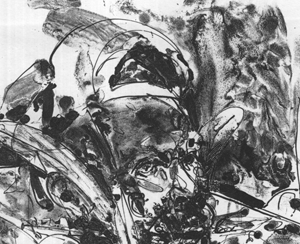
Toner Tusche
Traditional looking tusche drawing can be achieved on the polyester plates using a toner tusche . The toner tusche consists of two parts rubbing alcohol, one part water, one half part toner and one quarter part Hunt Speedball screen printing Drawing Fluid or pancake syrup. The function of the drawing fluid is to give the tusche enough stability to stay where it is brushed on the plates. If a less controlled mark is desired the drawing fluid can be left out. Brush the toner tusche on the plate or apply it with a drawing nib. Draw with the toner in thin layers or it will interfere with fusing and printing. As you draw, keep in mind that the toner prints a bit darker than the drawing looks on the plate. When the drawing is finished, let the plate dry. As it dries, the alcohol, water and drawing fluid will evaporate leaving only the toner.
Fusing the Toner to the Plate
When the toner tusche drawing is finished, fuse it to the plate by heating it in an oven at 250 degrees for four minutes. Preheat the oven with a cookie sheet inside. Place the polyester plate on the cookie sheet and watch the time carefully. Too much heat will warp and burn the plate. The distributors of Pronto Plates recommends the oven temperature be 190 degrees and the plate be heated for three minutes. Evidently all ovens do not heat the same. Pretest the oven heating temperature and time to insure proper fusing. The toner is fully fused to the plate when it won't wash off with water.
Making A Hot Plate Oven
A oven can be made using a hot plate. Since most print studios have hot plates it is simple to convert them to an oven. Using galvanized sheet metal that an inch or so longer than the hot plate make a simple oven top and sides by bending one half inches on two ends of the sheet. Place the bent metal on the hot plate so the open end faces the front. Using a slightly smaller piece of sheet metal bend two ends about one quarter inch on each end. This piece functions as the shelf on which the polyester plates are placed. Use a inexpensive oven thermometer to test the temperature. Between 190 and 220 degrees works well. The plates should be heated for between three and seven minutes in the hot plate oven.
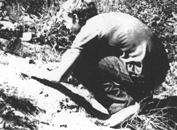
Photolithography
Photographic images are put on polyester plates using digital imaging techniques. High resolution scanners, printers and high memory capacity computers will insure the greatest detail and accuracy. Once the photographic image is printed on the Polyester plate using a laser jet printer the plate is ready to print as a fine art lithograph. The toner is fused to the plate in the printer. Another method of putting photo images on the polyester plates is using a toner based copier. Run the polyester plate through the copier instead of paper. The better the copier the better the results. Besides using a laser jet printer, copier and the toner tusche below are drawing material that will image a polyester plate.

Permanent Marker
Drawing Materials
The following is a list of material that can be used to image a polyester plate.
1. Black ball point pen.
2. Permanent Marker.
3. China Marker
4. Stones Crayon


Ball Point Pen and China Marker
Draw with them as you would on paper. Be sure to push hard enough so they are in the pores of the plate and not just on top of them. Marks made by any of the above can be scratched through or erased with a pencil eraser.
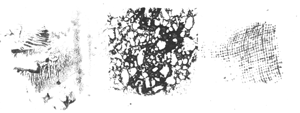
Texture Techniques
5. Future Acrylic Floor Polish. Add india ink to the Future so it can be seen of the plate.
6. Hunt Speedball Screen Filler. Dilute it with water, three parts water to one part screen filler.
7. Carbon based, waterproof India ink.
8. Carbon black acrylic paint
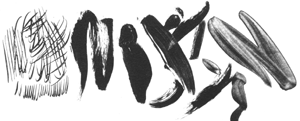
Wash Techniques
All of these materials can be used in a variety of way. Paint them on the
plate or use a drawing nib. Stamp a texture on the plate using them, or use a
tooth brush to spatter the material on to the plate.
Use an airbrush to draw with them or brush them in to alcohol for odd effects.

Resists
A resist is a mask used to retain white areas. Gum Arabic, water soluble lithographic pencils andcrayons and rubber cement are good resist materials. With any of these put them on the plate priorto using any drawing material. When they are completely dry draw over the top of them. To remove the resist use water and a sponge rubbing lightly. The resist will come off lifting the drawing material on top of it. Those areas will remain white in the midst of the drawing.
Printing a Polyester Plate
A Polyester Plate is ready to print emidiately after the artist is finished working on it. No acid or Gum Arabic is necessary. No asphaltum rub up, talc, or rosin is needed to prepare the plate for etching because no etching is required. By eliminating these steps much of the toxic nature of the old lithography process is eliminated.
To print a lithograph the plate must be wet prior to rolling it with ink. The distributor of the Polyester Plates recommends that the pH of the dampening water should be between four and one half and five and one half for optimum printing. They make a fountain solution that can be added to the water which will insure the proper pH. For example, the pH of the water in Boise is seven, so eight teaspoons of fountain solution are added to a liter to balance the pH. The fountain solution will remove drawing materials from the plate so fountain solution should be used sparingly or not at all when printing drawings. A teaspoon of fountain solution in a liter of water will not erase the drawing.
Thin soft paper like Rives Heavy Weight can be printed dry. Heavier printing papers need to be dampened to print well. Soak the paper of spritz it with a spray bottle. In either case blot the paper before printing on it. The ink should be a standard lithographic ink. When the ink and paper are prepared, the polyester plate should be placed on a wet piece of glass . The water will cause the polyester plate to stick to the glass and not be picked up when the ink roller is passed over it. As an added precaution use cloths pens or spring clamps to hold the front edge of the plate to the glass. Once the plate is stuck to the glass, wet its surface using a cellulose sponge and the pH balanced water. Run the inked roller across the plate several times then rewet the plate. Re-ink and repeat the process again until the plate is properly inked. Inking a polyester plate is the same as inking a lithographic stone. As a rule of thumb, if the plate won't accept the ink use less or no fountain solution. If the plate scums or over inks too quickly use more fountain solution in the wetting water.

Intaglio Press
The Polyester plates can be printed by hand or on an intaglio or lithographic press. To print using an intaglio press remove the felts and adjust the pressure so the upper roller is contacting the press be. Place three sheets of newsprint on the press bed. Place the plate on top of the newsprint and the print paper on top of that. Run them all through the press.

Litho Press with Backing Paper
Lithograhic Press
Printing on a lithographic press is also simple. Since Polyester Plates are thin it is necessary to put a clean lithographic stone, aluminum plate backer or a formica laminated three quarter inch plywood on the press bed. Place backing paper on the plate backer. Put the plate on the paper followed by , the printing paper, newsprint and greased tympan. Print the plate as usual.
Printing by Hand
To print by hand, ink the plate and place it face down on top of printing paper. Work on a flat smooth surface to insure an accurate print. Using a wood spoon or any other kind of burnisher rub the back of the plate methodically to cause the ink to come off the plate and on to the paper. Check the printing periodically by lifting one corner of the plate.
Reworking the Print
One nice qcharacteristic of a Polyester Plate is that it can be reworked during printing. Additional drawing or deleting can occur while the ink is still on the plate. Add marks to the plate using any of the drawing materials. Remove unwanted tonal areas by scraping them away with a razor blade or by using fountain solution or a pencil eraser. Since no etching or Gum Arabic is involved it is not necessary to counter etch or retch the plate. Once the modifications are finished, printing can continue immediately.
